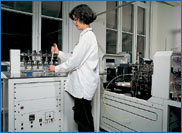 With a mass spectrometer like the one shown here at the ETH laboratory in Zürich, we will measure the stable isotopes of carbon, oxygen, nitrogen and sulfur in the rocks to study the sedimentary and hydrothermal processes at Lost City. Oxygen isotopes in particular give us important information about the temperatures at which the underlying rocks are altered and at which the minerals in the vent structures and sediments are deposited. Oxygen isotope signatures also help us document how the hydrothermal fluids that are derived from the subsurface mix with seawater and ultimately form the carbonate chimneys at Lost City. We also learn about how these systems evolve with time.
With a mass spectrometer like the one shown here at the ETH laboratory in Zürich, we will measure the stable isotopes of carbon, oxygen, nitrogen and sulfur in the rocks to study the sedimentary and hydrothermal processes at Lost City. Oxygen isotopes in particular give us important information about the temperatures at which the underlying rocks are altered and at which the minerals in the vent structures and sediments are deposited. Oxygen isotope signatures also help us document how the hydrothermal fluids that are derived from the subsurface mix with seawater and ultimately form the carbonate chimneys at Lost City. We also learn about how these systems evolve with time.
The carbon and oxygen isotope signatures of the calcium carbonate shells, which are abundant in the sediments, allow us to determine where and when the different species of minute marine organisms lived. With carbon and nitrogen isotope measurements of organic materials we can better understand which food and energy sources are used by the microbes and higher organisms that thrive on the hydrothermal fluids. Sulfur isotopes provide records of the source of sulfur and how the sulfur cycle in these systems is influenced by biological activity.